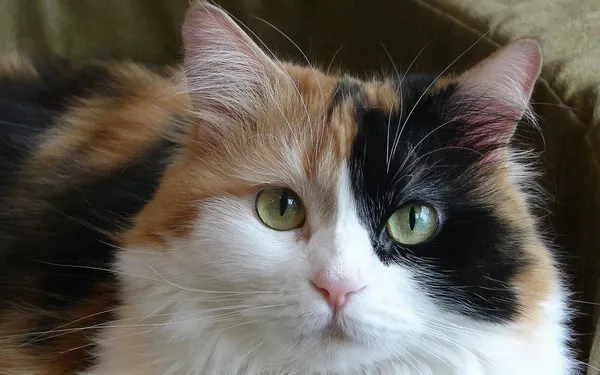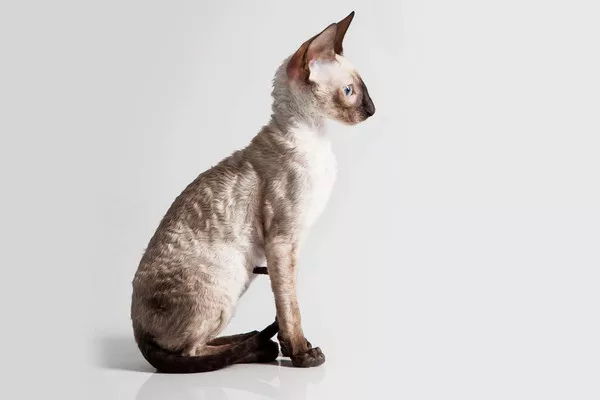Calico cats, with their distinctive tri-colored coats and unique patterns, have long captivated the hearts of cat lovers around the world. Among the intriguing features of calico cats is the phenomenon of their eyes turning red. This striking characteristic often raises questions among cat enthusiasts: why do calico cat eyes go red? In this article, we embark on a journey to explore the fascinating genetics and biological mechanisms that underlie this intriguing phenomenon.
The Charm of Calico Cats: A Triumphant Trio of Colors
Before delving into the intricacies of calico cat eye color, it’s essential to appreciate the beauty and charm of calico cats. Calico cats, also known as tortoiseshell-and-white cats, are characterized by their unique coat patterns, which typically feature a combination of white, black, and orange or cream-colored fur. These vibrant colors create a visually striking appearance that sets calico cats apart from other feline breeds.
Understanding Calico Cat Genetics: Unraveling the Genetic Puzzle
Calico cat eye color is influenced by a complex interplay of genetic factors, with each coloration contributing to the overall appearance of the cat’s eyes. To understand why calico cat eyes go red, it’s essential to explore the genetic mechanisms that govern eye color in cats.
Genetic Inheritance: The Role of X Chromosomes
Calico cats inherit their distinctive coat patterns and eye colors through a process known as X chromosome inactivation. Female cats possess two X chromosomes, one inherited from each parent, while male cats have one X chromosome and one Y chromosome. The gene responsible for coat color, known as the O gene, is located on the X chromosome.
X Chromosome Inactivation: A Genetic Mosaic
During embryonic development, one of the X chromosomes in female cells becomes inactivated in a process called lyonization. This random inactivation results in patches of cells with different X chromosomes, leading to the formation of a genetic mosaic. In calico cats, the coat pattern is determined by the random distribution of cells with active X chromosomes carrying either the black or orange coat color gene.
Determination of Eye Color: Melanin and Pigmentation
Eye color in cats is determined by the presence of melanin, a pigment that gives color to the iris. The amount and distribution of melanin in the iris dictate the color of the eyes, with variations ranging from blue and green to yellow and brown. In calico cats, the presence of both black and orange coat colors can result in a unique combination of melanin production, leading to the appearance of red or copper-colored eyes.
The Science Behind Red Eyes: Melanin and Light Reflection
The phenomenon of calico cat eyes turning red is due to a combination of factors related to melanin production and light reflection. Let’s explore the scientific principles that contribute to this intriguing occurrence:
Melanin Distribution:
In calico cats, the distribution of melanin in the iris is influenced by the presence of both black and orange coat colors. The random distribution of cells with active X chromosomes carrying genes for black or orange coat color results in patches of melanin production in the iris. The combination of black and orange pigments can create a unique reddish-brown hue in the eyes, especially when viewed under certain lighting conditions.
Light Absorption and Reflection:
The color of a cat’s eyes is also influenced by the way light interacts with melanin in the iris. Melanin absorbs certain wavelengths of light, while reflecting others, giving rise to the perception of color. In calico cats, the presence of melanin pigments in varying concentrations and distributions can result in the absorption and reflection of light in such a way that the eyes appear red or copper-colored, particularly when viewed in bright or natural light.
Genetic Variation and Phenotypic Expression:
Genetic variation among individual calico cats can contribute to variations in eye color and appearance. Factors such as the specific genes inherited from the cat’s parents, the random distribution of active X chromosomes during embryonic development, and environmental influences can all influence the phenotypic expression of eye color in calico cats. As a result, some calico cats may exhibit more intense red or copper-colored eyes than others, depending on their genetic makeup and environmental factors.
Environmental Factors: Influence on Eye Color Perception
While genetics play a significant role in determining eye color in calico cats, environmental factors can also influence the perception of eye color under different lighting conditions. Let’s explore how environmental factors can impact the appearance of calico cat eyes:
Lighting Conditions:
The color and intensity of light can affect the perception of eye color in calico cats. In bright or natural light, the reddish-brown hue of calico cat eyes may appear more pronounced, while in dim or artificial light, the color may appear darker or less distinct. The angle and direction of light can also influence how light interacts with melanin pigments in the iris, altering the perceived color of the eyes.
Eye Health and Condition:
The overall health and condition of a cat’s eyes can also influence their appearance. Factors such as eye inflammation, infection, or injury can affect the clarity and color of the eyes, potentially altering the perception of eye color in calico cats. Regular veterinary check-ups and proper eye care are essential for maintaining the health and appearance of a cat’s eyes and ensuring that any changes in eye color are promptly addressed.
Individual Variation:
Just as each calico cat possesses a unique coat pattern and personality, individual variation in eye color and appearance is also common among calico cats. Some cats may exhibit more intense red or copper-colored eyes, while others may have lighter or darker hues. These variations are influenced by a combination of genetic factors, environmental influences, and individual characteristics, making each calico cat truly unique.
Conclusion: Celebrating the Beauty of Calico Cat Eyes
In conclusion, the phenomenon of calico cat eyes turning red is a fascinating example of the intricate interplay between genetics, biology, and environmental factors. Through a combination of X chromosome inactivation, melanin production, and light reflection, calico cats exhibit a unique and captivating eye coloration that sets them apart from other feline breeds.
As cat enthusiasts marvel at the beauty of calico cat eyes, it’s essential to appreciate the genetic diversity and individuality that contribute to the striking appearance of these beloved felines. Whether gazing into eyes that sparkle with shades of red, copper, or gold, cat lovers can find joy in the unique beauty and charm of calico cats and celebrate the wonders of nature’s genetic palette.






















